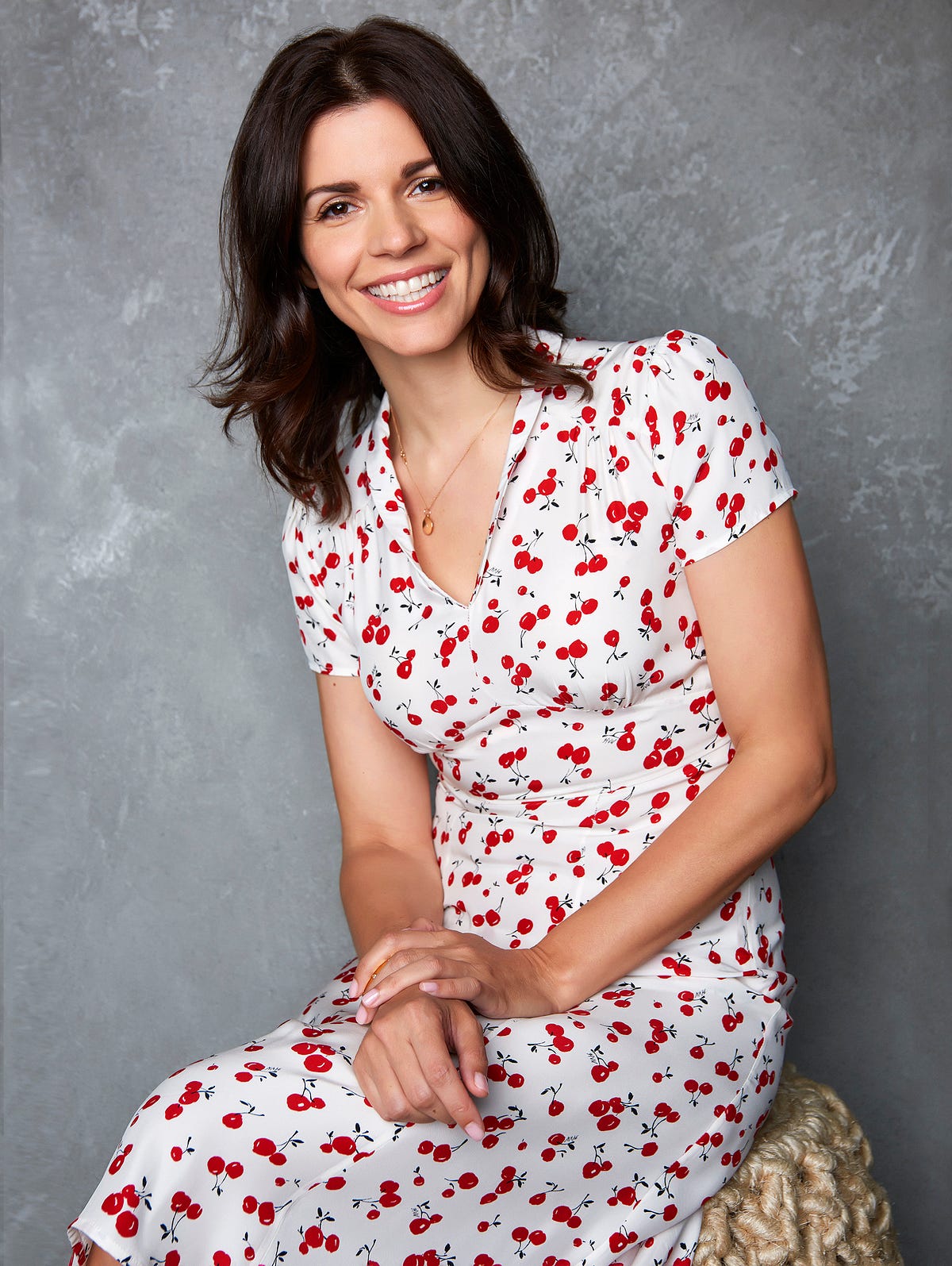“I’d like to start a movement to bring meditation to schools” With Sarrah Hallock, Co-Founder of THE WELL

…Bringing meditation to schools. When meditation has made its way into public schools, the results are more than promising. Mediation has been shown to help young people in a range of ways from improved test scores and attendance to reducing stress and anxiety and helping kids better cope with chronic stress and trauma.
I had the pleasure of interviewing Sarrah Hallock, Co Founder of THE WELL, a modern membership-based wellness club designed for busy urban professionals in the heart of New York City. Sarrah is also an Integrated Health Coach and Nutritionist.
Thank you so much for doing this with us! What is your backstory?
Prior to my career in Health and Wellness, I spent the better part of the last 20 years helping turn consumer products into household names. As Brand Director for vitaminwater, I oversaw triple digit growth from the early days of the brand through to the sale to The Coca Cola Company for $4.1b in 2007. I went on to be an investor and VP of Marketing for bai, an enhanced water beverage that sold to Dr Pepper Snapple Group for $1.75b in 2016. I then helped launch WTRMLN WTR as VP of Marketing and an investor in 2014.
I started experiencing health problems in the midst of working 60–80 hours a week in the startup world. My symptoms ranged from exhaustion, anxiety, insomnia to gaining 25 pounds over the course of a year. I was so fatigued that falling asleep at my desk was a pretty regular occurrence. After almost two years of seeing numerous doctors and being told there was nothing wrong, I finally found a functional medicine doctor who diagnosed me with an autoimmune disease called Hashimoto’s Thyroiditis. While I was grateful for a diagnosis, what I didn’t realize at the time, was this would be the beginning of an incredible passion for health and wellness.
I ultimately left my marketing career to study nutrition and wellness and start a private health coaching practice that led me to co found THE WELL.
I am now the co founder of THE WELL and also serve as an advisor and/or investor to various consumer brands including POP & BOTTLE, Health-Ade Kombucha, WTRMLN WTR, Skinny Dipped, Chef’s Cut Jerky, Vital Proteins, Bulletproof and One Bar.
Can you share the most interesting story that happened to you since you started your career?
When I look back now, getting sick was the best thing that ever happened to me, both personally and professionally. It awakened a desire to really understand the connection between the food I eat and my body, how powerful self-care can be and ultimately put me on a trajectory to marry my passion for health and my career.
Are you working on any new or exciting projects now?
Yes! I am working on launching THE WELL. THE WELL is a modern membership-based wellness club designed for busy urban professionals in the heart of New York City. We recognize both the benefits of Western medicine and the wisdom of Eastern healing and have built a science-backed ecosystem for wellness. Our integrative medicine doctors, health coaches and skilled practitioners work together under one roof to build customized plans uniquely suited to each member and their goals. Opening in Spring 2019, the 13,000-square-foot club includes a full-service spa with steam and sauna, an organic restaurant and vitamin bar, reflexology lounge, yoga and meditation studios, private training gym and classroom with innovative weekly programming.
Between work and personal life, the average adult spends nearly 11 hours looking at a screen per day. How does our increasing screen time affect our mental, physical, and emotional health?
There is a growing body of research showing correlation between increased screen time and mental, physical and emotional health. It’s an issue that needs to be taken seriously. A 2017 study in the journal Clinical Psychological Science found a correlation between time spent on new media, such as social media platforms and smartphones, and instances of mental health issues, particularly among young people. And a study by the University of Pittsburgh reveals that increased social media use is linked to higher levels of perceived social isolation. No matter how often we tell ourselves to put down the phone, or yell at our partners to get off their phones, this is a bigger societal issue and needs to be addressed at all levels including the makers of smartphones and devices. Citing myriad studies around the negative effects of excessive screen time on developing brains, as well as research from prominent doctors and scholars, two of Apple’s largest investors called on the company to develop more sophisticated parental controls. The responsibility of helping to solve the problem is also going to be on the makers of the devices to be responsible and to get involved in helping to solve the problem.
Can you share your top five ways people can improve mental wellness and create a healthy relationship with technology?
Invest in an alarm clock. One of my favorite ways to set technology boundaries at home is to get an old-fashioned alarm clock. This is a game changer because you won’t have to rely on your phone as an alarm and can move it away from your bedside while you sleep. If you wake up in the middle of the night, you won’t be able to check texts, work emails or a quick scroll through Instagram. There is a growing body of evidence that the blue light emitted from smartphones and tablets affects the body’s natural sleep rhythms which has far-reaching health effects from weight gain to cardiovascular health.
Set your out of office and stick to it. When you’re out of office, set up an auto response that let’s everyone know you won’t be checking emails, but take it a step further and kindly request if people need a direct response from you to follow up with you directly on the date of your return. A lot of us feel compelled to check and read our emails when we are away to avoid feeling overwhelmed when we return from holiday, which can put a serious damper on plans for R&R. When you ask people to follow up with you when you return, it takes some of the pressure off to stay connected.
Take a social media detox. Delete Instagram, email or an app that you think you cannot live without from your phone (don’t worry, it’s only for a few days!). This serves as a physical and emotional reminder, that you CAN live without that app and you might be pleasantly surprised with what you do with your newly found free time.
Turn OFF notifications on your device. Facebook, Twitter, Instagram, Google and your favorite apps are financially incentivized to get you to interact. They are betting on your FOMO and sending constant reminders of what you’re missing when you’re offline. These companies are competing with each other for your screen time and are spending billions of dollars to design features to keep you glued to their products. But you have more power than you think. Always opt out of push notifications, you can log in if and when you need an update. Without the constant pop-ups and reminders, you’re less likely to engage. And don’t worry, you’re not really missing anything.

51% of Americans say they primarily use their smartphone for calls. With the number of robocalls increasing, what are ways people can limit interruptions from spam calls?
With the massive growth of robocalls, this is a real issue. Cell phone carriers can now identify and block spam calls, typically offered as a paid feature, and it is a worthwhile investment. Only answer calls from numbers you recognize, and if you happen to answer a spam call, immediately block the number. It won’t eliminate spam all together, but it is effective. You can also register both your landline and cell phone numbers for free with donotcall.gov
Between social media distractions, messaging apps, and the fact that Americans receive 45.9 push notifications each day, Americans check their phones 80 times per day. How can people, especially younger generations, create a healthier relationship with social media?
For starters, Turn OFF notifications on your device. Facebook, Twitter, Instagram, Google and your favorite apps are financially incentivized to get you to interact. They are betting on your FOMO and sending constant reminders of what you’re missing when you’re offline. These companies are competing with each other for your screen time and are spending billions of dollars to design features to keep you glued to their products. But you have more power than you think. Always opt out of push notifications, you can log in if and when you need an update. Without the constant pop-ups and reminders, you’re less likely to engage. And don’t worry, you’re not really missing anything.
80% of smartphone users check their phones before they brush their teeth in the morning. What effect does starting the day this way have on people? Is there a better morning routine you suggest?
Creating a mindful morning routine can be the difference between a frenzied, rushed start to the day and a peaceful, stress free routine that actually sets you up for a productive day ahead. Unfortunately, smartphones generally are not part of a peaceful morning routine, but you don’t have to go cold turkey on your current habit. Set small goals for yourself to see how far you can get into your regular morning routine without checking your phone. Do you shower first? Try pushing your first check in until after your shower. Or maybe after your coffee. Start slowly and build up. Eventually, you might be able to make it all the way until you get to the office before checking your phone. This frees you up to create other positive habits in the morning like meditating, stretching, writing in a journal or simply being present and bringing a more conscious awareness to your morning.
Can you please give us your favorite life lesson quote?
The difference between an ordeal and an adventure is your attitude.
If you could start a movement that would bring the most amount of wellness to the most amount of people, what would that be?
Bringing meditation to schools. When meditation has made its way into public schools, the results are more than promising. Mediation has been shown to help young people in a range of ways from improved test scores and attendance to reducing stress and anxiety and helping kids better cope with chronic stress and trauma.
What is the best way our readers can follow you on social media?
@sarrahhallock on instagram


